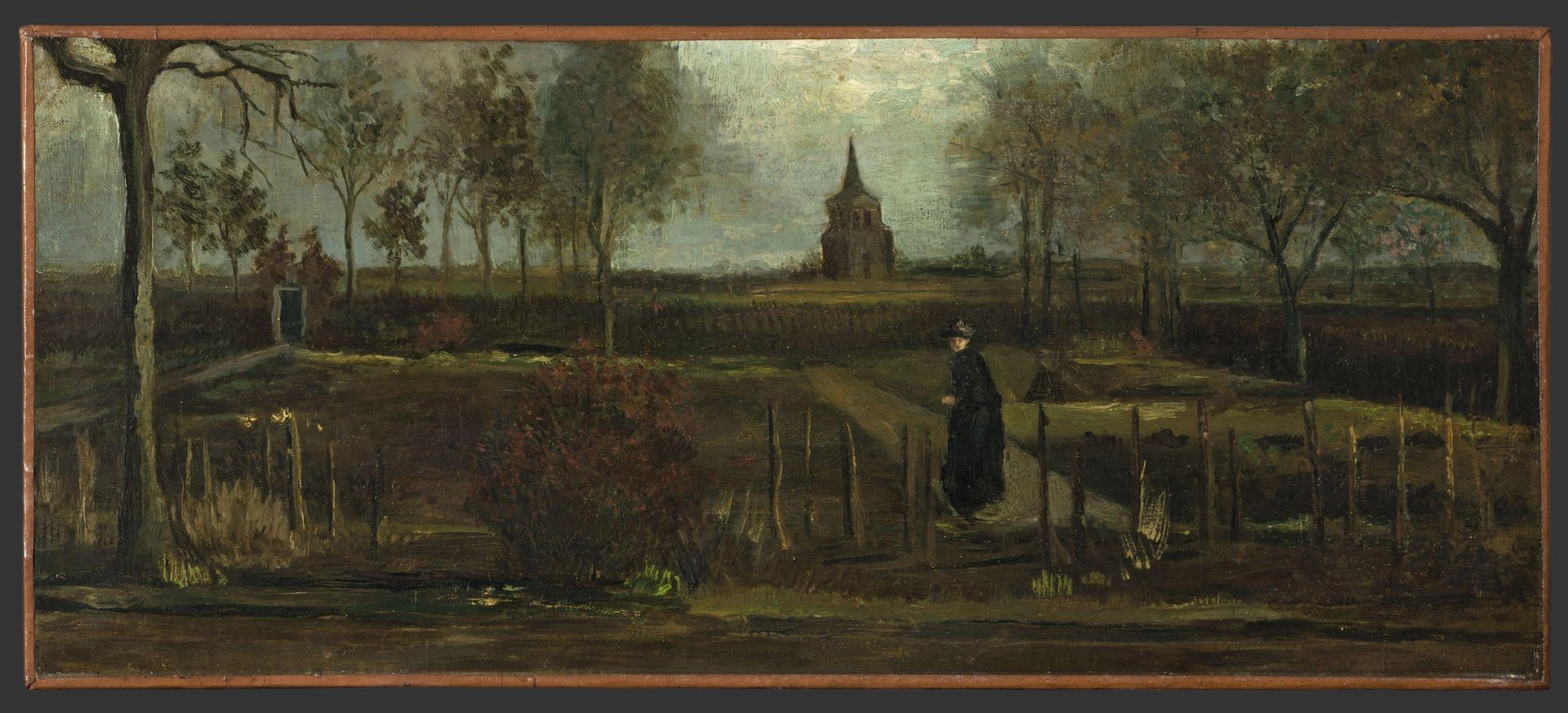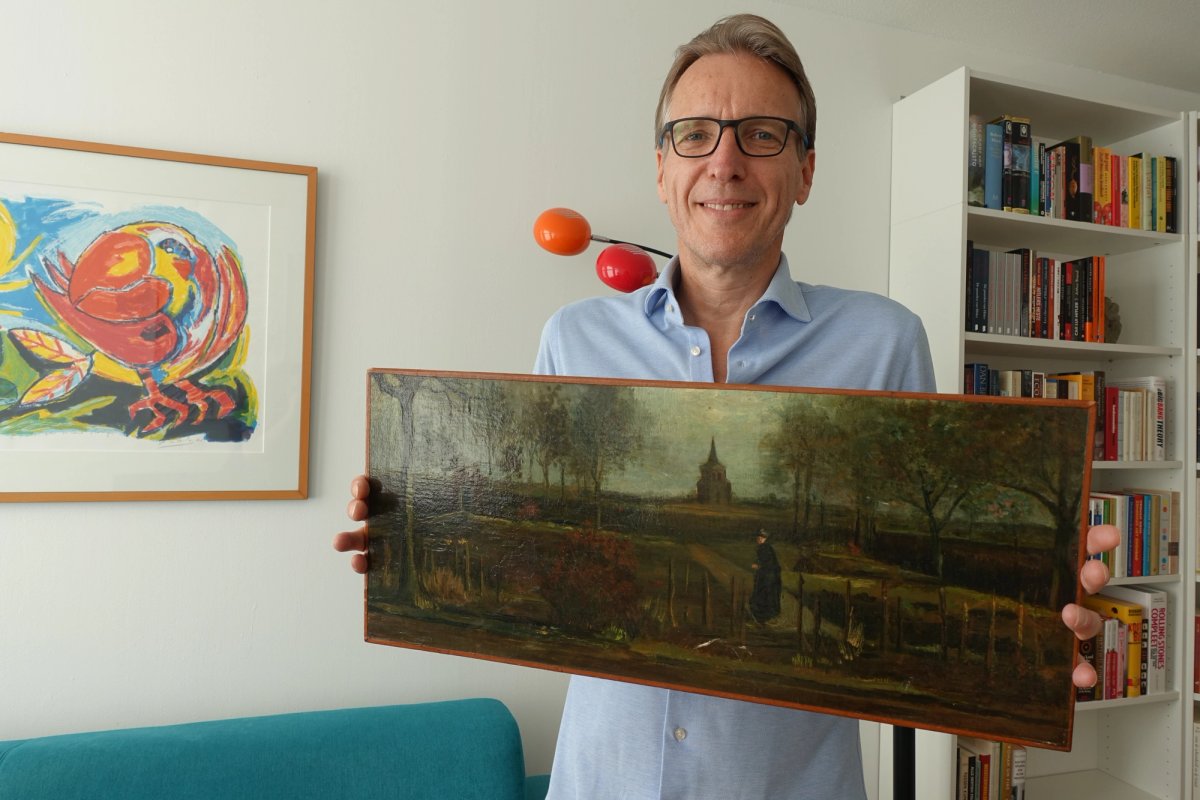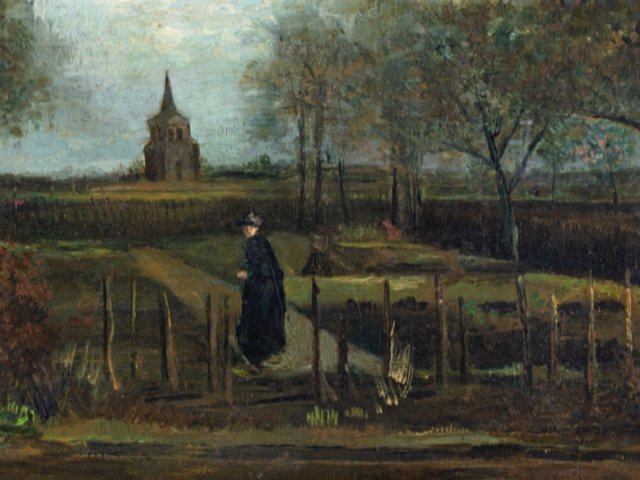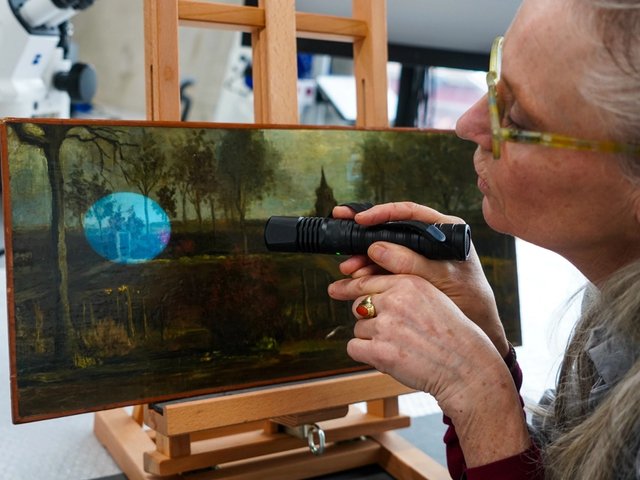Andreas Blühm, the director of the Groninger Museum, was having lunch in an Amsterdam café on Monday when the call came through. It was art detective Arthur Brand, with an apparently mundane message: “You can come over now.”

Andres Blühm, director of the Groninger Museum since 2012
Credit: Groninger Museum, Groningen; Photo: Ewoud Rooks
Blühm’s heart was beating fast. It was the long-awaited news about the recovery of Van Gogh’s The Parsonage garden at Nuenen in Spring, which had been on loan to an exhibition in Laren, where it had been stolen more than three years earlier. The smash-and-grab raid at the Singer Laren museum took place in the early hours of 30 March 2020, when a thief broke through the glass door of the public entrance.

Thief at the Singer Laren museum, captured on a security camera, 30 March 2020 Credit: Singer Laren
In April 2021, Dutch police had arested Nils M., who was later sentenced to eight years imprisonment for stealing the Van Gogh and also a Frans Hals painting. The Hals, Two Laughing Boys (around 1626), had been stolen from the Hofje van Mevrouw van Aerden museum in Leerdam on 26 August 2020, five months after the Van Gogh.
Having to deal with an art theft is every museum director’s worst nightmare, so it has been a difficult time for Blühm. There was also a false start early last year when another contact (not Brand) had suggested that a recovery was imminent, but it never materialised.
It was on 7 September this year that Brand, a highly successful art recover specialist who had long been on the trail, told Blühm to come to Amsterdam four days later. The museum director was instructed to wait in a café which was two blocks from the art detective’s apartment.
Blühm did not have much of an appetite that day, so it hardly mattered that he had not quite finished lunch when the call came through. By this time Brand had made a quick inspection of the painting, being fairly sure it was the real thing. Although he had put aside a pair of gloves, to inspect the painting without adding his own fingerprints, in the heat of the moment these were forgotten and he simply held it up.
The museum director arrived a few minutes later. He was almost shaking with emotion. “I was super excited”, Blühm later told The Art Newspaper. There were a few seconds of silence. He picked up the painting, turned it over to look at the reverse, saying, with great relief, “Yes, that’s it”.
Blühm had worked at the Van Gogh Museum in 1993-2005, so he knows the artist’s work well, and the telltale exhibition labels on the reverse were there. Nearby in Brand’s apartment was the large blue Ikea bag in which it had been handed over, along with the pillow which had been inside in a clumsy attempt to protect the fragile painting.
The recovery by Brand was organised in conjunction with the Art Crime Unit of the Dutch police. It is believed that police officers were stationed in and around his apartment, when the intermediary arrived on his doorstep. However, a police source says that they did not identify the intermediary or speak with him.
Brand told The Art Newspaper that as far as he knows, no reward had been paid. He says that he has “no idea” where the Van Gogh has been; his task was to encourage the intermediary to return it. This was probably done for a variety of motives: there was little to be gained by holding onto the picture, the person regretted it had been lost by a public collection and he probably felt antagonistic towards the thief. The intermediary asked where the painting should be delivered, with Brand responding “my home would be best”.
After authenticating the picture, Blühm phoned the head of conservation at the Van Gogh Museum, saying that he would be delivering "a stolen Van Gogh"—and he would be bringing it along very shortly.
The Van Gogh Museum’s immediate examination showed that the painting (oil on paper on panel) has suffered some cracks. All can be repaired, although one crack in the lower centre (just below the figure of the woman) will need to be retouched, to disguise the damage. But considering what had occurred, the work had survived remarkably well.
The painting had been insured for €2.5m, which was paid out by the insurance company to the Groninger Museum last year. The painting therefore belongs to the insurers.
The museum now has the right to buy back Van Gogh back for that sum, which it will now do. This is likely to happen this autumn, after the formalities and payment arrangements have been made. Following conservation, it will go back on display, hopefully later this year. The stolen Hals still remains unrecovered.

The parsonage in Nuenen, with part of the back garden and the extension which once served as Van Gogh’s studio
Credit: Martin Bailey
The Parsonage garden at Nuenen in Spring, painted in March 1884, depicts a view from the back garden of the house of Vincent’s parents. The artist was then living with them, using a small side extension of their home as his studio.

Vincent van Gogh's The Parsonage garden at Nuenen in Spring (March 1884)
© Groninger Museum (photograph by Marten de Leeuw)
The view in the painting is from just outside Van Gogh’s studio, looking towards the far end of the garden. Beyond this lay fields and then the tower of the old church. The body of the church had been demolished a few decades earlier and the tower would be pulled down a year later, in spring 1885.

Detail of Van Gogh’s The Parsonage garden at Nuenen in Spring (March 1884)
Credit: Groninger Museum, Groningen
The woman in black in the painting remains a mystery. If an actual person, she seems to be young or middle aged, so it is unlikely to be Vincent’s elderly mother Anna. It could well be one of his sisters.
But it is also possible that she represents Vincent’s sweetheart Margot Begemann, who lived next door. She was 12 years older than him. They had an affair in the summer of 1884, to the concern of both sets of parents who thought they were a most unsuitable couple.
The relationship ended when Margot made a failed attempt at suicide. One morning in September 1884 they were walking, quite possible in the fields just beyond the parsonage, when Margot suddenly fell to the ground. Vincent quickly discovered that she had swallowed the poison strychnine and got her to vomit.
He managed to take her home. A doctor was summoned and administered an antidote, which saved her. She was quickly sent away from Nuenen, to the city of Utrecht, thus ending their relationship. The Parsonage garden at Nuenen in Spring could be a depiction of Margot and the landscape where they soon courted.







